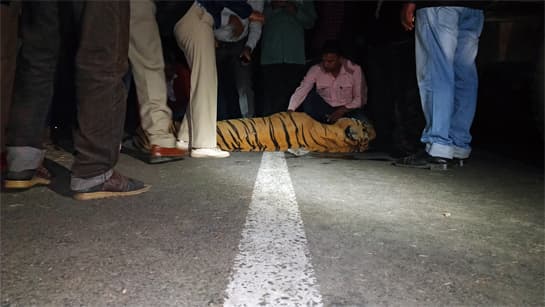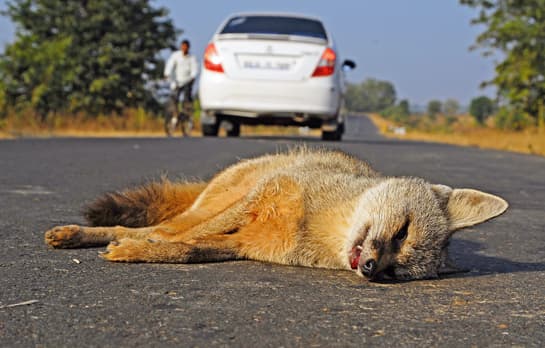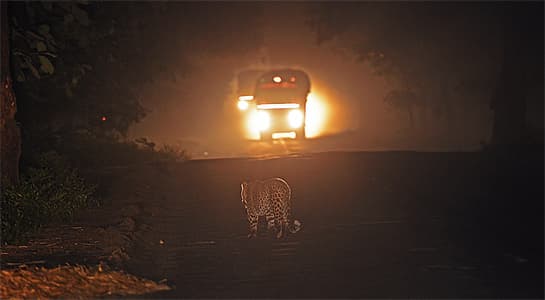Rizwan Mithawala elucidates on an effort to engage concerned citizens through a mobile-based application developed by the Wildlife Conservation Trust to collect data on mortality of wild animals on roads, railway lines and irrigation canals across the country.

Photo: Sheetal Navgire/WCT
“But in the modern world there is no time,” wrote Rachel Carson in her seminal book Silent Spring. She wrote of time as the essential element that allows life to adapt to change and reach equilibrium. While her book speaks of the hazards of chemical fertilisers, her lament holds true for the current onslaught launched on India’s wildlife by its rapidly-advancing road network. At a construction pace of 22 km. a day, and thousands of kilometres cutting through designated Protected Areas (PAs), the country’s highways are giving its wildlife neither chance nor choice.
Apart from the 24,000 km. of roads that pass through PAs, over 1,200 passenger and freight trains run on railway lines that slither across these prime wildlife habitats, imperiling India’s endangered wildlife indiscriminately. Figure this — roads and railways have snuffed out 16 tigers in the last five years; over 150 elephants have been killed by speeding trains in the last eight years. In a short span of 63 days between December 2017 and February 2018, trains have killed 10 elephants in the state of Assam alone!
The numbers present a situation of exigency; one that can force a wildlife biologist to make appeals to the public. “The scale of this problem is huge, and the damage being inflicted is irreversible,” says Milind Pariwakam, a wildlife biologist working with the Wildlife Conservation Trust (WCT). “Small research teams can at best monitor a few roads at a time. But roads are being built everywhere; and no matter how large an organisation you are, it’s impossible to gather information on all the animals that die on our roads every day.” Pariwakam recently spearheaded the launch of ‘Roadkills’, a mobile-based application to collect data on mortality of wild animals on roads, railway lines and irrigation canals across the country. “We felt that the only way we could tackle the problem was by engaging concerned citizens; and that’s how this citizen science project came into being. The project is an attempt by WCT to involve citizens in collecting data that can be useful for researchers and infrastructure planners across the country in reducing wildlife mortality. The data will help identify sensitive locations where safe wildlife crossing structures can be installed. The pace at which new roads are being built close to or inside critical wildlife habitats and existing roads and railways lines being expanded is very fast,” says Dr. Anish Andheria, President of WCT. “Unless we have rapid and continuous access to data on wildlife movement and mortality along these roads, we will not be able to suggest mitigation measures before or at the planning stages of these projects. A conservation budget for mitigation measures must be a part of project planning at the blueprint stage,” suggests Dr. Andheria. “Post budgeting, it’s next to impossible to add mitigation expenses to the project cost. Fine-grained information on these sensitive areas is needed to stipulate effective, location-specific mitigation measures along linear projects. This would also bring down the overall mitigation cost.”

Photo: Anish Andheria
LOSING THEM FAST
While one often hears of ambitious plans about increasing tiger numbers, India’s apathy towards the plight of this umbrella species for conservation is underlined by the lack of data on tigers killed on roads and railway lines. There is no official record of tiger roadkills and railkills beyond the last five years; and the actual number is probably higher than the official figure of 16. What is worse, species less charismatic than tigers and elephants die a silent death on asphalt. Countless endangered species of amphibians, reptiles, birds and small mammals die unmourned and unrecorded. “We are losing them fast, and forever,” says Pariwakam, whose team of researchers sampling roads running through forest areas in Maharashtra have come up with worrying numbers – 200 roadkills on Mul Road in the Chandrapur Forest Circle in a span of three months; 50 roadkills on Gondia-Kohmara Road in two months. And that is just scratching the surface.
‘What can we do?’ – is less of a question and more of an expression of helplessness and hopelessness in India. A simple app now enables virtually anyone with a smart phone to add to the strength of the conservation movement. Public involvement can put pressure on the government as well as on experts and project proponents who often seek to dilute effective mitigation measures to save on their project costs.
The citizen science project will not just democratise the collection of data, but will make it available to anyone. Information submitted by citizens will be accessible in the public domain on maps posted on www.roadkills.in. Infrastructure planners, wildlife researchers and students wanting more detailed access to the data will get it under a Creative Commons licence. Apart from the general public, WCT has partnered with several other wildlife conservation organisations and is looking for more partners willing to help make the data collection effort more comprehensive.
Hopefully, the hard data generated will enable planners and other government agencies to take preventive actions to lower wildlife mortality. In the 1970s, India had a legendary track record in wildlife conservation. The time has come for our country to demonstrate leadership again, this time in building wildlife-friendly infrastructures.

Photo: Nikhil Tambekar
Over the next five years, the Indian government plans to build over 83,000 km. of roads. These economic corridors must take into account the imperatives of ecological connectivity, which has everything to do with our ecological and therefore our water, food and climate security. The death of endangered species must never be accounted for as acceptable collateral damage in our race for infrastructure development.
First published in: Sanctuary Asia, Vol. XXXVIII No. 4, April 2018.
——————————————————————————————————————————————————————
About the Author: Rizwan Mithawala is a Conservation Writer with the Wildlife Conservation Trust and a Fellow of the International League of Conservation Writers.
——————————————————————————————————————————————————————
Disclaimer: The author is associated with Wildlife Conservation Trust. The views and opinions expressed in the article are his own and do not necessarily reflect the views and opinions of Wildlife Conservation Trust.
Related Links
- Report Roadkills
- Whose Right of Way?
- India’s rising tiger figures
- Wildlife Crime: Prosecution Hurdles
- Why Pitting Ecology vs Economy is Dangerously Naive
- Recycling needs Rethinking
